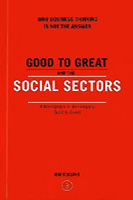
|
 |
Good to Great and the Social Sectors: Why Business Thinking Is Not the Answer A Monograph to Accompany Good to Great Jim Collins 
Format: Paperback, 42pp. ISBN: 9780977326402 Publisher: Collins Pub. Date: November 30, 2005 Average Customer Review: For Bulk Orders Call: 626-441-2024 Description and Reviews From The Publisher: Jim Collins Answers the Social Sector with a Monograph to Accompany Good to Great. 30-50% of those who bought Good to Great work in the Social Sector.
About the Author Jim Collins is a student and teacher of enduring great companies -- how they grow, how they attain superior performance, and how good companies can become great companies. Having invested over a decade of research into the topic, Jim has co-authored three books, including the classic Built to Last, a fixture on the Business Week bestseller list for more than five years, generating over 70 printings and translations into 16 languages. His work has been featured in Fortune, The Economist, Business Week, USA Today, Industry Week, Inc., Harvard Business Review and Fast Company. Driven by a relentless curiosity, Jim began his research and teaching career on the faculty at Stanford Graduate School of Business, where he received the Distinguished Teaching Award in 1992. In 1995, he founded a management laboratory in Boulder, Colorado, where he now conducts multi-year research projects and works with executives from the private, public, and social sectors. Jim has served as a teacher to senior executives and CEOs at corporations that include: Starbucks Coffee, Merck, Patagonia, American General, W.L. Gore, and hundreds more. He has also worked with the non-corporate sector such as the Leadership Network of Churches, Johns Hopkins Medical School, the Boys & Girls Clubs of America and The Peter F. Drucker Foundation for Non-Profit Management. Jim invests a significant portion of his energy in large-scale research projects -- often five or more years in duration -- to develop fundamental insights and then translate those findings into books, articles and lectures. He uses his management laboratory to work directly with executives and to develop practical tools for applying the concepts that flow from his research. In addition, Jim is an avid rock climber and has made free ascents of the West Face of El Capitan and the East Face of Washington Column in Yosemite Valley. Excerpts Good to Great and the Social Sectors Why Business Thinking Is Not the Answer by Jim Collins The following are short excerpts from the monograph Good to Great and the Social Sectors: Why Business Thinking Is Not the Answer, published in 2005 by Jim Collins. The full monograph can be obtained from most online booksellers. In addition, you might like to visit the Lecture Hall section of this Web site, where you can find audio excerpts from the monograph. Author’s Note During my first year on the Stanford faculty in 1988, I sought out professor John Gardner for guidance on how I might become a better teacher. Gardner, former Secretary of Health, Education and Welfare, founder of Common Cause, and author of the classic text Self-Renewal, stung me with a comment that changed my life. “It occurs to me, Jim, that you spend too much time trying to be interesting,” he said. “Why don’t you invest more time being interested.” I don’t know if this monograph will prove interesting to everyone who reads it, but I do know that it results from my growing interest in the social sectors. My interest began for two reasons. First is the surprising reach of our work into the social sectors. I’m generally categorized as a business author, yet a third or more of my readers come from non-business. Second is the sheer joy of learning something new—in this case, about the challenges facing social sector leaders—and puzzling over questions that arise from applying our work to circumstances quite different from business. I originally intended this text to be a new chapter in future editions of Good to Great. But upon reflection, I concluded that it would be inappropriate to force my readers to buy a second copy of the book just to get access to this piece—and so we decided to create this independent monograph. That said, while this monograph can certainly be read as a stand-alone piece, I’ve written it to go hand-in-hand with the book, and the greatest value will accrue to those who read the two together. I do not consider myself an expert on the social sectors, but in the spirit of John Gardner, I am a student. Yet I’ve become a passionate student. I’ve come to see that it is simply not good enough to focus solely on having a great business sector. If we only have great companies, we will merely have a prosperous society, not a great one. Economic growth and power are the means, not the definition, of a great nation.
Jim Collins Boulder, Colorado July 24, 2005 ********************************************************* We must reject the idea—well-intentioned, but dead wrong—that the primary path to greatness in the social sectors is to become “more like a business.” Most businesses—like most of anything else in life—fall somewhere between mediocre and good. Few are great. When you compare great companies with good ones, many widely practiced business norms turn out to correlate with mediocrity, not greatness. So, then, why would we want to import the practices of mediocrity into the social sectors? I shared this perspective with a gathering of business CEOs, and offended nearly everyone in the room. A hand shot up from David Weekley, one of the more thoughtful CEOs—a man who built a very successful company and who now spends nearly half his time working with the social sectors. “Do you have evidence to support your point?” he demanded. “In my work with nonprofits, I find that they’re in desperate need of greater discipline—disciplined planning, disciplined people, disciplined governance, disciplined allocation of resources.” “What makes you think that’s a business concept?” I replied. “Most businesses also have a desperate need for greater discipline. Mediocre companies rarely display the relentless culture of discipline—disciplined people who engage in disciplined thought and who take disciplined action—that we find in truly great companies. A culture of discipline is not a principle of business; it is a principle of greatness.” ********************************************************* The pivot point in Good to Great is the Hedgehog Concept. The essence of a Hedgehog Concept is to attain piercing clarity about how to produce the best long-term results, and then exercising the relentless discipline to say, “No thank you” to opportunities that fail the hedgehog test. When we examined the Hedgehog Concepts of the good-to-great companies, we found they reflected deep understanding of three intersecting circles: 1) what you are deeply passionate about, 2) what you can be the best in the world at, and 3) what best drives your economic engine. Social sector leaders found the Hedgehog Concept helpful, but many rebelled against the third circle, the economic engine. I found this puzzling. Sure, making money is not the point, but you still need to have an economic engine to fulfill your mission. Then I had a conversation with John Morgan, a pastor with more than 30 years of experience in congregational work, then serving as a minister of a church in Reading, Pennsylvania. “We’re a congregation of misfits,” said Morgan, “and I found the idea of a unifying Hedgehog Concept to be very helpful. We’re passionate about trying to rebuild this community, and we can be the best in our region at creating a generation of transformational leaders that reflects the full diversity of the community. That is our Hedgehog Concept.” And what about the economic engine? “Oh, we had to change that circle,” he said. “It just doesn’t make sense in a church.” “How can it not make sense,” I pressed. “Don’t you need to fund your work?” “Well, there are two problems. First, we face a cultural problem of talking about money in a religious setting, coming from a tradition that says love of money is the root of all evil.” “But money is also the root of paying the light and phone bills,” I said. “True,” said Morgan, “but you’ve got to keep in mind the deep discomfort of talking explicitly about money in some church settings. And second, we rely upon much more than money to keep this place going. How do we get enough resources of all types—not just money to pay the bills, but also time, emotional commitment, hands, hearts, and minds?” Morgan put his finger on a fundamental difference between the business and social sectors. The third circle of the Hedgehog Concept shifts from being an economic engine to a resource engine. The critical question is not “How much money do we make?” but “How can we develop a sustainable resource engine to deliver superior performance relative to our mission?” ********************************************************* I do not mean to discount the systemic factors facing the social sectors. They are significant, and they must be addressed. Still, the fact remains, we can find pockets of greatness in nearly every difficult environment—whether it be the airline industry, education, healthcare, social ventures, or government-funded agencies. Every institution has its unique set of irrational and difficult constraints, yet some make a leap while others facing the same environmental challenges do not. This is perhaps the single most important point in all of Good to Great. Greatness is not a function of circumstance. Greatness, it turns out, is largely a matter of conscious choice, and discipline. ********************************************************* Business executives can more easily fire people and—equally important—they can use money to buy talent. Most social sector leaders, on the other hand, must rely on people underpaid relative to the private sector or, in the case of volunteers, paid not at all. Yet a finding from our research is instructive: the key variable is not how (or how much) you pay, but who you have on the bus. The comparison companies in our research—those that failed to become great—placed greater emphasis on using incentives to “motivate” otherwise unmotivated or undisciplined people. The great companies, in contrast, focused on getting and hanging on to the right people in the first place—those who are productively neurotic, those who are self-motivated and self-disciplined, those who wake up every day, compulsively driven to do the best they can because it is simply part of their DNA. In the social sectors, when big incentives (or compensation at all, in the case of volunteers) are simply not possible, the First Who principle becomes even more important. Lack of resources is no excuse for lack of rigor—it makes selectivity all the more vital. Copyright © 2005 Jim Collins, All rights reserved. Find Items On Similar Subjects |
|

Books by Jim Collins LEADERSHOP 
The Essential Lists BOOKS TO READ BEFORE YOU LEAD 
Grow Your Leadership Skills NEW AND UPCOMING LEADERSHIP BOOKS 
Classic Leadership Books BOOKS TO READ BEFORE YOU LEAD |
 |
| ||
 | © 2019 LeadershipNow All materials contained in https://www.LeadershipNow.com are protected by copyright and trademark laws and may not be used for any purpose whatsoever other than private, non-commercial viewing purposes. Derivative works and other unauthorized copying or use of stills, video footage, text or graphics is expressly prohibited. |
||